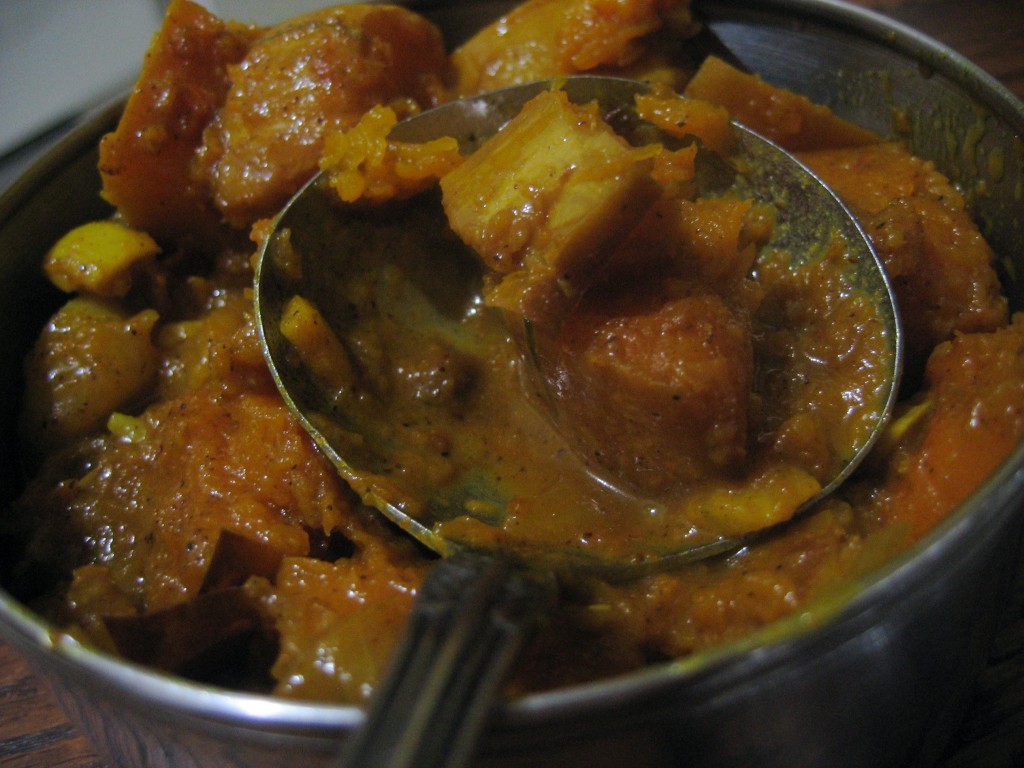 Technically, winter squash season started several weeks ago when we harvested our first batch of butternuts. It was one of those winsome moments in farming; so picturesque that it doesn’t seem possible that it’s real. A garden cart brimming with rosy-golden squash.
Technically, winter squash season started several weeks ago when we harvested our first batch of butternuts. It was one of those winsome moments in farming; so picturesque that it doesn’t seem possible that it’s real. A garden cart brimming with rosy-golden squash.

Even though we harvested the butternut squash several weeks ago, I’ve been waiting to use them until Autumn finally revealed herself. So it’s lucky that winter squash like these keep perfectly on the counter for several months because Autumn seemed to be even more of a procrastinator than usual this year.
In my family, winter squash were generally sweet things–dusted with brown sugar and dotted with raisins. However, inspired by my friend Kristen’s savory submission to a recent potluck, I decided to try a curry. The spices serve as a counterpoint to the squash’s natural sweetness. It seemed a mantle to grace Autumn’s sunburnt shoulders.
Continue Reading…
Posted 14 years, 8 months ago at 8:47 pm. Add a comment
 Like a delusional castaway on a deserted island, I’ve been seeing boats everywhere. Ever since writing about Zucchini Boats, my mind seems to have been opened to all the possibilities. Bananas, melons, bell peppers, mushrooms, tomatoes. It seems almost anything can become a “boat.”
Like a delusional castaway on a deserted island, I’ve been seeing boats everywhere. Ever since writing about Zucchini Boats, my mind seems to have been opened to all the possibilities. Bananas, melons, bell peppers, mushrooms, tomatoes. It seems almost anything can become a “boat.”
Cucumbers seem especially suited to boat-ness. Many people already make them without knowing it by scraping out the seeds. What’s left behind is the perfect cavity to fill with something delicious. In this recipe, I chose to fill it with a salmon salad. A nice addition to my recipe would be some grated Parmesan cheese. I didn’t add it this time because we were also having goat cheese stuffed squash blossoms, and I didn’t want a cheese overload.
I think I like these better than the zucchini boats. They are crisp, fresh, and easy. Perfect for summer because they require no oven. I suppose they are raw? If you consider canned salmon raw, I suppose . . . ? I’m not up on the rule book for Raw Foods. At the very least, these boats don’t require any actual cooking, only assembly.
And the best part? They are best eaten like a hot dog.
Cucumber Boats
2 cucumbers
1 can salmon, sustainably harvested if you can find it
1 lemon
2 Tbs capers
1-2 small bell peppers, any color
1/4 cup grated Parmesan cheese (opt.)
salt and pepper
Put the salmon in a medium bowl and break it into pieces. You can pick out the bones if you want. Zest the lemon over the bowl. Then roll it under you palm a few times to release the juices. Cut it in half and squeeze the juice into the bowl, straining the seeds through your fingers. Add the capers. Chop the peppers into small pieces and add them the to bowl too. If you’re using cheese, add it now too. Cover the bowl and set it in the fridge to chill for a bit. Cut the cucumbers in half lengthwise. Use a spoon to scrape out the seeds. Fill the cavity with the salmon salad. Eat with your hands, like a hot dog.
Posted 14 years, 9 months ago at 6:34 am. 3 comments
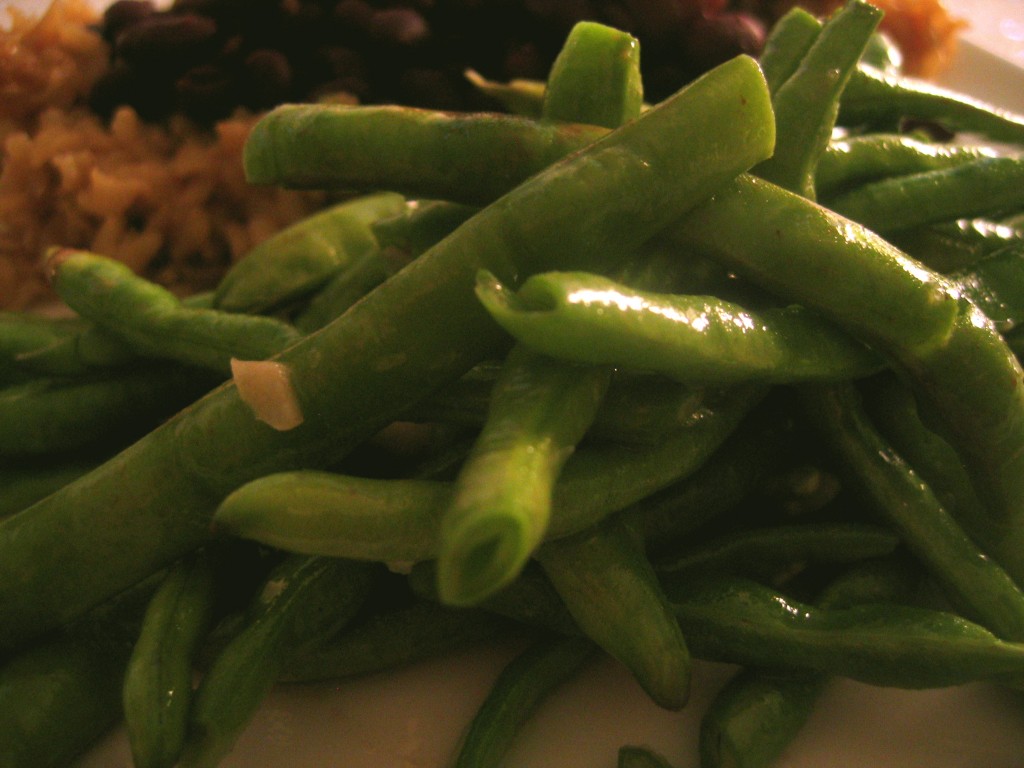 This is just a quick post about a recipe Mr. Quotidian and I have been enjoying the past several weeks. Yard Long Green Beans, although they look like field peas that must be shelled, are best used like pole or snap beans. (Except for eating raw. They are bitter and chewy before they are cooked.) For any gardeners reading, these beans should be classified under Foods to Grow for Survival. The plants are magnificently prolific. At City Roots, we harvest bushels every few days.
This is just a quick post about a recipe Mr. Quotidian and I have been enjoying the past several weeks. Yard Long Green Beans, although they look like field peas that must be shelled, are best used like pole or snap beans. (Except for eating raw. They are bitter and chewy before they are cooked.) For any gardeners reading, these beans should be classified under Foods to Grow for Survival. The plants are magnificently prolific. At City Roots, we harvest bushels every few days.
And they are quite tasty too. I could eat a whole recipe by myself. But then there wouldn’t be any leftovers to used in the Bevy and Beans and Basil dish (recipe to come soon!). It’s such a quandary.
Yard Long Bean Sauté
2 bunches of Yard Long Green Beans
2 Tbs butter, lard, or olive oil
2 anchovy fillets
4 cloves of garlic
sea salt
Bring a large pot of salted water to a boil. Meanwhile, rinse your beans and snap them to a size you like. You could also peel and chop your garlic now. I like big chunks of garlic in my beans, but if you prefer a more refined mince, go for it. When the water boils, add the beans and blanch them for 45-60 seconds, just enough for them to turn bright green and cook slightly. This step evens out the cooking times, as some beans are larger than others. Strain them out and drain in a colander. Heat a large skillet over medium high heat and melt your fat. When it looks shimmery on the surface, add the anchovies and use a wooden spoon to smoosh them into the oil. They should completely disintegrate. Then add the beans and mix until they are evenly coated. I find tongs to be helpful here. Add the garlic and mix again. Cook the beans to your desired doneness – crunchy, al dente, or mushy. Turn off the heat and salt them to taste.
Posted 14 years, 9 months ago at 6:53 am. 1 comment
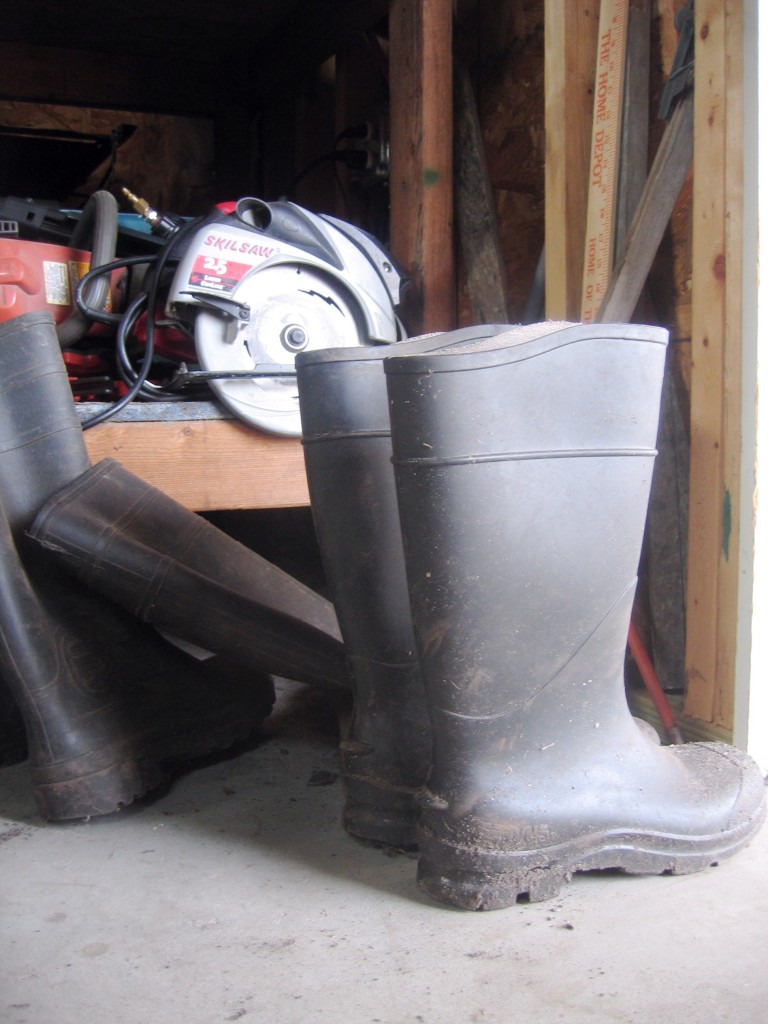
It is an almost universally acknowledged fact that a man in possession of an item of food is in want of its origin. One can barely bring up the topic of last night’s dinner without someone bemoaning the fact that people don’t know where their food comes from. What they mean to highlight when they say this is the industrialization of our food system. By and large, not only do we no longer know the farmer who grew our food, we can’t even be exactly certain as to its continent of origin. And that’s true. A quick look around the produce aisle proves that most apples and garlic are from China, the asparagus is from Chile, and the raspberries are from God-knows-where. We could all get to know our food better, whether that means stopping by a farmer’s market or finally figuring out what’s killing the squash.
The bone I do wish to pick, however, is with the shallowness of the statement. “People don’t know where their food comes from,” is, at its core, a statement of geography. Nothing else. Concepts of terroir aside, we must recognize that food is more than geography. There is more than a where, there is also a how. People don’t know how their food comes to them. They have no idea the kind of effort, skill, and knowledge that goes into growing food.
Continue Reading…
Posted 14 years, 9 months ago at 6:25 am. Add a comment
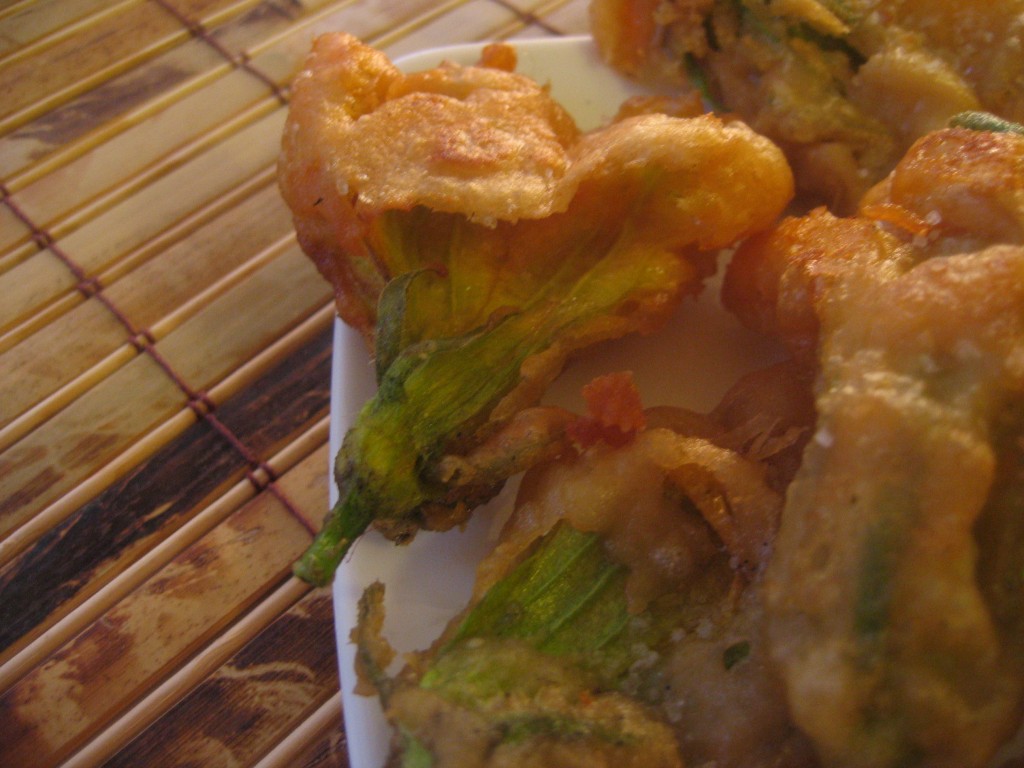
Oh. My. Goodness.
Now I understand.
People always get this crazy glint in their eyes when they talk about squash blossoms. And then they shake their heads sadly at me when they realize I am one of the uninitiated squash blossom eaters. Feeling like I was either missing out on a great snack or a great opportunity to make fun of foodies crazier than myself, I fried up some squash blossoms last night. And . . .
Oh. My. Goodness. Gracious.
What, you mean you’ve never eaten squash blossoms before? (Eyes widen in surprise while shaking head.)
Continue Reading…
Posted 14 years, 9 months ago at 10:21 pm. 1 comment
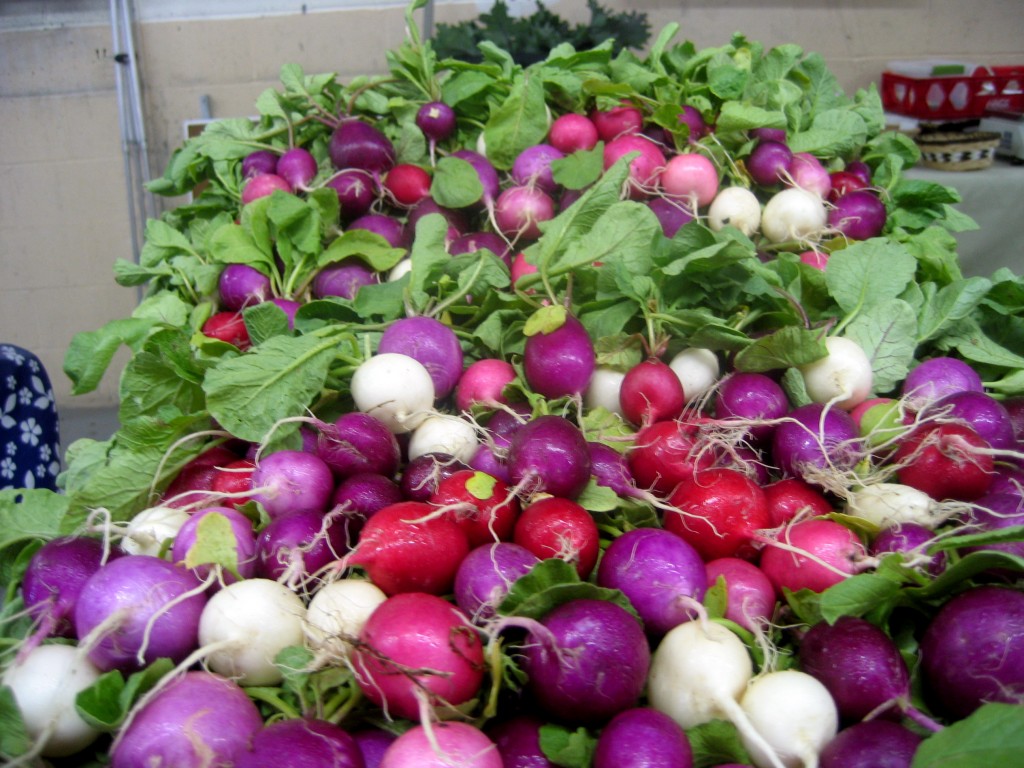 On Friday, City Roots harvested over 80 pounds of beauty in the form of these Easter Egg Radishes. We grew them alongside the carrots as a companion crop. Fast growing radishes help the slow growing carrots by keeping the soil from crusting over before they germinate and shading out most weeds with their leaves. They also help mark rows as carrot tops can be hard to see.
On Friday, City Roots harvested over 80 pounds of beauty in the form of these Easter Egg Radishes. We grew them alongside the carrots as a companion crop. Fast growing radishes help the slow growing carrots by keeping the soil from crusting over before they germinate and shading out most weeds with their leaves. They also help mark rows as carrot tops can be hard to see.
As other volunteers brought in crate after crate of radishes for me to arrange, I began to feel like I was working in a candy shop. Such vibrant lollipop-like colors are usually confined to the air conditioned candy aisle at the supermarket, not a hot field. For awhile, I felt more like an artist than a farmer, lining the pearly white with the lipstick red and hanging the amethyst purple next to the blushed pink. A lady at the farmer’s market said the next day that they are pretty enough to put in a bowl as a centerpiece, forget about eating them. But I have to disagree. Something so beautiful deserves to eaten, not roll around in bowl till they’re old and wrinkly.
All of my previous experience with radishes has been of the bagged salad variety. So, spurred on by the current beauty and abundance, I rubbed the dirt off of one and took my first bite of a real radish. True to their siren song of colors, my radish began as cool and enticingly crunchy as a cucumber. But then, once I’d committed and swallowed, it threatened to drown my adventure seeking taste buds in a fiery wasabi-like spiciness. I was hooked.
Continue Reading…
Posted 15 years, 1 month ago at 2:17 pm. 1 comment
 One of the snags people often get caught in when eating a local diet is the ebb and flow of specific foods. First, most foods are not in season year round. They come and go like the tide. They might be obtainable, but you have to travel far to get them. Second, when they are available, they are available in the same way that a tidal wave is available.
One of the snags people often get caught in when eating a local diet is the ebb and flow of specific foods. First, most foods are not in season year round. They come and go like the tide. They might be obtainable, but you have to travel far to get them. Second, when they are available, they are available in the same way that a tidal wave is available.
Lettuce is one of those foods. Somewhere along the line, it acquired the status of poster child for healthy eating. People on diets opt for the salad bar instead of fried chicken. Health nuts get bragging rights based on how many salads they eat. Prewashed, mixed, and bagged lettuce is a staple of busy moms trying to feed their family more vegetables. And then there’s me. I think I eat fairly healthfully. And yet, for most of the year, salads (at least those made from lettuce) are conspicuously absent from my table. In the south, where I live, the lettuce season is very short- from about March to mid April, and then again in September. Lettuces thrive in cooler spring and fall temperatures. The intense heat that other sun bathing vegetables like tomatoes adore, exhausts lettuces. But in the spring, before the days get too hot, lettuce comes rolling in from the garden and crashes in waves over farmer’s market stands. It is vibrant green (or red, or purple), succulent, tender, and without a trace of bitterness.
Continue Reading…
Posted 15 years, 2 months ago at 12:05 pm. 5 comments
 Technically, winter squash season started several weeks ago when we harvested our first batch of butternuts. It was one of those winsome moments in farming; so picturesque that it doesn’t seem possible that it’s real. A garden cart brimming with rosy-golden squash.
Technically, winter squash season started several weeks ago when we harvested our first batch of butternuts. It was one of those winsome moments in farming; so picturesque that it doesn’t seem possible that it’s real. A garden cart brimming with rosy-golden squash.






